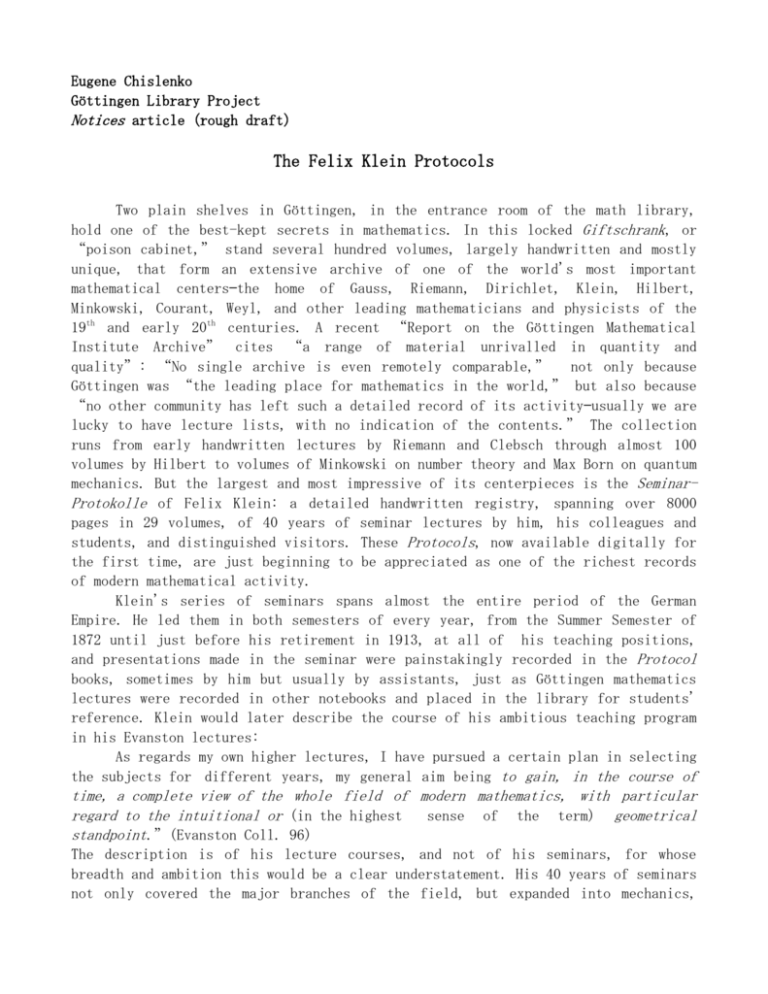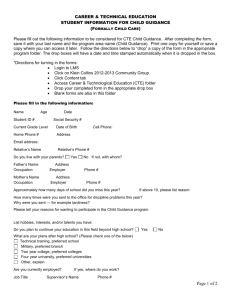Notices - Courant Institute of Mathematical Sciences
advertisement

Eugene Chislenko Göttingen Library Project Notices article (rough draft) The Felix Klein Protocols Two plain shelves in Göttingen, in the entrance room of the math library, hold one of the best-kept secrets in mathematics. In this locked Giftschrank, or “poison cabinet,” stand several hundred volumes, largely handwritten and mostly unique, that form an extensive archive of one of the world's most important mathematical centers—the home of Gauss, Riemann, Dirichlet, Klein, Hilbert, Minkowski, Courant, Weyl, and other leading mathematicians and physicists of the 19th and early 20th centuries. A recent “Report on the Göttingen Mathematical Institute Archive” cites “a range of material unrivalled in quantity and quality”: “No single archive is even remotely comparable,” not only because Göttingen was “the leading place for mathematics in the world,” but also because “no other community has left such a detailed record of its activity—usually we are lucky to have lecture lists, with no indication of the contents.” The collection runs from early handwritten lectures by Riemann and Clebsch through almost 100 volumes by Hilbert to volumes of Minkowski on number theory and Max Born on quantum mechanics. But the largest and most impressive of its centerpieces is the SeminarProtokolle of Felix Klein: a detailed handwritten registry, spanning over 8000 pages in 29 volumes, of 40 years of seminar lectures by him, his colleagues and students, and distinguished visitors. These Protocols, now available digitally for the first time, are just beginning to be appreciated as one of the richest records of modern mathematical activity. Klein's series of seminars spans almost the entire period of the German Empire. He led them in both semesters of every year, from the Summer Semester of 1872 until just before his retirement in 1913, at all of his teaching positions, and presentations made in the seminar were painstakingly recorded in the Protocol books, sometimes by him but usually by assistants, just as Göttingen mathematics lectures were recorded in other notebooks and placed in the library for students' reference. Klein would later describe the course of his ambitious teaching program in his Evanston lectures: As regards my own higher lectures, I have pursued a certain plan in selecting the subjects for different years, my general aim being to gain, in the course of time, a complete view of the whole field of modern mathematics, with particular regard to the intuitional or (in the highest sense of the term) geometrical standpoint.”(Evanston Coll. 96) The description is of his lecture courses, and not of his seminars, for whose breadth and ambition this would be a clear understatement. His 40 years of seminars not only covered the major branches of the field, but expanded into mechanics, astronomy, geodesy, hydrodynamics, electricity, elasticity theory, and in the last years before his retirement in 1912, the psychology and teaching of mathematics. Before settling in Göttingen permanently in 1886, Klein taught, for several years each, in Erlangen, Munich, and then Leipzig, filling the first ten Protocol volumes with the presentations there. These early seminars tended to focus on geometry and function theory, but without much unity of subject matter within each semester, with most of the 1870s seminars catalogued as “Seminar on Various Topics” or “Seminar on Various Topics in Geometry and Algebra.” The constant change of topics from week to week can be seen in the presentation list in his first seminar (1:OO), taught jointly with his teacher Alfred Clebsch in Göttingen just before Klein's move to his first professorship: The presentations are on “Geometric Problems of the 3rd and 4th Degree”, “The Physical Theory of the Northern Lights”, “Rational Transformations”, “The Elements of Arithmetic”, “Contributions to the Analytic Geometry of Space”, “The Imaginary in Geometry”, “Linear Planes of the Fourth Degree”, “The Elements of Function Theory, “Investigations on Algebraic Functions”, “On the Theory of Newtonian and Logarithmic Potential”, “The Distribution of Heat in a Sphere”, “The Tautochrone Problem”, and so on (see Figure OO). The next year, the 23-year-old Klein began his new professorship at Erlangen with his revolutionary Erlangen Program, unifying the various geometries of the time by classifying them by their corresponding groups of transformations. He had recently proved that non-Euclidean geometry is consistent if and only if Euclidean geometry is, and he would go on to do groundbreaking work in many other areas, becoming, along with Hilbert and Poincaré, the last of the mathematicians who could claim to have a grasp of the entire field. His Erlangen seminars focused mainly on geometrical topics, bringing his students to the cutting edge of the field... [description of mathematical seminars] In the mid-1890s, the death of Leopold Kronecker and the retirement of Karl Weierstrass set off a chain of appointments in German mathematics departments, where professorships were rare and highly prestigious. Klein took the opportunity to turn the leading department in the country into the leading department in the world, arranging for the hiring of David Hilbert in 1895 and Hermann Minkowski in 1902. A series of collaborative seminars ensued. After teaching alone from 1872 to 1896, Klein taught four seminars in a row with Hilbert, and by 1909 he would coteach five seminars with the physicist Karl Schwarzschild, six together with Ludwig Prandtl and Carl Runge, and, in 1905-7, a series of four seminars with both Hilbert and Minkowski on differential equations and automorphic functions. Meanwhile Klein, having warned against “the danger of a separation between abstract mathematical science and its scientific and technical applications” (Evanston Coll. 50), had also begun to place more and more emphasis on bridging mathematics and the other disciplines. The early Protocol volumes are already peppered with interesting applications of the mathematical and physical theories discussed in the seminars. Among these are “Vibrations of a Violin String”(1:327-329) in the Winter Semester 1877-78, “The Theory of Billiards”(8:166-189) in the Summer 1887 seminar on the theory of tops, and “The Calculation of Death Charts”(11:228-236) in the Summer 1893 seminar on probability theory. The focus on topics outside pure mathematics, however, becomes much more pronounced during the last 15 of the Protocols' 40 years. In 1898, after several years of seminars on pure mathematics, Klein and Hilbert together taught two seminars on mechanics (14:1-100 and 105-243), with presentations ranging from the more standard theoretical topics to “On the Bicycle”(14:146-155) and another “On the Theory of Billiards”(14:206-218). A subsequent mechanics seminar in the winter of 1901-02 includes a presentation “On Seismographs”(18:151-163). The Winter 1900-01 seminar “Applications of Projective Geometry”(16:WS1-112) [[[determine citation format for split-pagination volumes]]] includes reports on “Hermann Ritter's Perspectograph”(16:WS35-57), “HauckMauer's Perspective-Drawing Apparatus”(16:WS58-69), “On Painter's Perspective”(16:WS70-77), and “Stereoscopic Vision”(16:WS100-112). Looking through the volumes from the turn of the century, one finds a recurring interest in ships. The Winter Semester 1899-1900 seminar (15:203-431), “The Theory of Ships,” includes presentations ranging from fairly abstract to surprisingly specific: “On the Stable Balance of Swimming Bodies”(15:381-392), “On the Stability of Ships”(15:214-229), “Spatial Contents and Sinking of a Ship”(15:205-213), “Sails and Rudders”(15:304-312), “Ship Waves in a Canal”(15:320-327), and even “On the 'Seiches' ”(15:367-372), a discussion of the occasional sudden changes in the water level (“Seiches” or standing waves) on Lake Geneva, developing formulas with constant frequency and decreasing amplitude and showing their concord with empirical observations on the lake's shore. The Winter 1901-02 seminar on mechanics includes a presentation on “Ship Resistance in a Calm Sea”(18:201-227), and the winter 1903-04 seminar on hydrodynamics has one “On Turbines”(20:122-132). The Winter 1907-08 seminar (27:1-125), co-taught with Prandtl, Runge, and Wiechert, is a “Hydrodynamics seminar with special attention [[[???]]] to the hydrodynamics of ships”(27:1). Its presentations on more general topics in hydrodynamics give way to “Ship Waves”(27:82-94), “The Theory of Ship Propellers”(27:95-110), and “On Ship Resistance in Unbounded Water”(27:111-125). continuing through the first half of the next semester (27:127-235) with “Ship Oscillation”(27:131-138), “Continuation of the Presentation on Ship Resistance”(27:141-149), “Lounz's Theory of Turbines”(27:150-157), and “Ship Resistance in Canals”(27:158-165). Along with ship theory, the turn-of-the-century seminars show an increased emphasis on air and space. These topics can be found occasionally in the earlier volumes, starting in the very first pages of the Protocols with an 1872 presentation on the “Physical Theory of the Northern Lights”(1:2-3). A report “On Hill's Theory of the Moon's Movement”(11:152-158) can also be found among the middle volumes. But no significant part of any seminar before 1900 is devoted to these topics. The Summer 1902 seminar [[[???]]], by contrast, has astronomy as its general theme, and includes many presentations treating the moon and orbits. The Summer 1908 seminar “Dynamic Meteorology”(27:127-235), whose first half is the continuation of the winter seminar on ships, includes presentations on the “Thermodynamics of the Atmosphere”(27:180-187), treating topics such as humidity, the mixing of air masses, and cloud formation; “The General Circulation of the Atmosphere”(27:188-196); “Cyclones”(27:197-214); and “Helmholtz's Treatment of Atmospheric Movement”(27:215-234). The final Protocol volume contains four seminars, three of them devoted to the psychology and education of mathematics. The Winter Semester 1909-1910 seminar (29:1-72) is titled “Mathematics and Psychology,” and listed on the volume's cover as “Psychological Foundations of Mathematics.” As Klein states in his opening speech to the seminar, The general topic is the intersection points of mathematics and philosophy. The more strictly logical questions will be treated in the parallel lecture course by Zermelo; here we shall discuss all of the other mental processes which accompany the logical processes and in part precede them, and which will here be called simply psychological. 29:1 Klein spends most of his opening lecture laying out a set of suggested presentation topics, which give an indication of his non-technical interests at the time. He puts forward, with descriptions, six central themes: 1. On the working methods of productive mathematicians 2. On the development of basic mathematical intuition in the growing individual 3. The formation and epistemological importance of mathematical axioms 4. On the errors of mathematicians 5. Implications for mathematical instruction 6. On the position of mathematics in the system of the sciences. 29:2-5 The seminar includes many reports and informal discussions, recorded in summary form by Klein himself, on these and other topics, including Klein's recounting of his own mathematical development as well as that of Gauss, Lie, and other mathematicians. Klein, who had much to say on these topics, made ten of the seminar's presentations himself. Many figures outside mathematics make at least a brief appearance, among them Aristotle, Kant, Goethe, Schiller, Hegel, Comte, and Spencer (29:59ff). The Winter 1910-1911 seminar (29:75-147) covers mathematics education, running parallel to Klein's lecture course on the modern development of mathematics education and focusing especially on elementary schools (cf. 29:75). Klein had always been a talented administrator, and having played a central role in building up his country's leading mathematics department, its leading mathematics journal Mathematische Annalen, and its first national association of mathematicians, he had turned much of his attention to education, chairing many committees and championing a program of reforms in higher education that later became known simply as the Klein reforms. His Winter 1910-11 seminar, though, is one of the signs of his interest not only in universities, but in education at all levels. Several short presentations, mostly on various aspects on mathematics education in elementary schools (29:76-96), are followed by a unified series of lectures on “Teacher Education,” providing a tightly structured overview of the current structure and problems of training mathematics teachers for elementary schools (29:97-125). Rounding out the seminar are similar overviews of conditions in vocational schools, girls' schools, and in Austria (29:126-147). The last seminar in the Protocols, organized by Klein but led during his illness by his former student Rudolf Schimmack, is an ambitious survey of the state of mathematics education across Europe (Summer 1912, 29:277-450). The presentations on Germany tend to compare the current system to the past and to other countries. “To What Extent is Euclid's Teaching Continued in Today's German Schoolbooks?”(29:288-296) compares Euclid's presentation of his material with contemporary textbooks, particularly the influential ones by Kambly and BerendsenGölting, describing a fading but still very noticeable Euclidean influence. “On the Reform Movement in Germany”(29:370-376) provides a historical overview of the mathematics education reform movement and an alternative report on BerendsenGölting's textbook. There is also a “Comparison of the Organization of Higher Learning in Germany and France”(29:279-287), and many presentations on individual foreign countries. England and France receive special attention. “The Highschool System and Traditional Euclid Lessons in England”(29:297-307) describes the structure, history, and recent reforms of English schools and of methods of teaching Euclid, including a discussion of textbooks and examination questions, and is followed by a second report on “Recent Reforms of Geometry Education in England”(29:308-320). “The Reform Movement in France”(29:377-381) describes a movement away from abstraction and toward concrete examples and applications, and an emphasis on the concept of function. “The New Form of Geometry Education in France”(29:338-351) treats in more detail Méray's textbook Nouveaux éléments de géométrie, his innovations in treating displacement, translation, rotation, and other basic notions, and his influence, and criticizes him for what it describes as a counterintuitive approach and a lack of economy in treating axioms. Other seminar participants cover “The Question of Geometry Education in Italy”(29:352-361), “Reform Efforts in Mathematics Education in Hungarian Middle Schools”(29:414425), and “The Reform Movement in Arithmetic and Algebra Education in the United States and England”(29:389-394), and there are also “A Sketch of the School System in Switzerland”(29:398-399), a bleak report “On the Organization of Schools in Russia”(29:400-404), and a more hopeful report “On the Organization of Schools in Finland”(29:405-413). “The State of Reform Efforts in Mathematics Education in Some Other Nations”(29:395-397) summarizes some advances in Sweden and Romania, but laments that Belgium remains backward in many respects, and Holland “hardly better”(29:397). Germany receives its share of comparative criticism as well; “The Intuitive Design of Basic Geometry Education”(29:362367), for example, advocates a reorganization of German geometry education into a two-tier approach following that of Austria, so that students who do not reach the higher levels of education still have a thorough and intuitively comprehensible overview of geometry. [description of pictures] Klein's seminars had a deep and widespread impact, not only on participants such as Hurwitz, Planck, Weyl, and Zermelo, but on the United States as well. Klein had made repeated trips to the U.S., visiting many universities and giving his classic Evanston Colloquium lectures at the World's Fair in Chicago, and had organized funding for a growing stream of American mathematics students to study with him in Göttingen. Harry Walter Tyler from MIT wrote back enthusiastically to William Osgood: I know of no one who can approach him as a lecturer....He's certainly acute, fertile in resource, not only understands other people, but makes them understand him, and seems to have a very broad firm grasp of the philosophical relations and bearings of different subjects, as well as great versatility and acquaintance with literature. Tyler was one of many Americans to be marked by the breadth and power of Klein's teaching, and to leave their own mark, first in his Protocols and then in the world at large: six of the American Mathematical Society's early presidents and two of the University of Chicago's first three mathematics professors were students of Klein. The ideas Klein developed and expounded continue to inspire new research today. One especially accessible recent example is the book Indra's Pearls, by David Mumford, Caroline Series, and David Wright, which uses computers to present – in very vivid color – developments of Klein's geometric ideas that are far too intricate to draw by hand. The Protocols themselves have never been published, and have not received the attention they deserve; David Rowe, a leading historian of modern mathematics, wrote about the Protocols: “although it would appear that few have perused them since they were first placed there, they are undoubtedly the best single source documenting the rich panoply of ideas that characterized Klein's teaching activity”(p.34 n.5). Interest in the Protocol volumes, though, might soon begin to spread much more quickly, now that a digitization initiative, supported by the Clay Mathematics Institute, has used the latest in scanning technology to digitize the complete Protocols in November of 2006. The entire set is now widely available in a digital edition, online at www.octavo.com. With both Klein and his many distinguished students in mind, one can confidently say what Richard Courant said, in his foreword to Constance Reid's biography of Hilbert: “I trust that the book will fascinate not only mathematicians but everybody who is interested in the mystery of the origin of great scientists in our society.”(V) Bibliography Frei, Günther, ed. Der Briefwechsel David Hilbert – Felix Klein. Göttingen: Vandenhoeck und Ruprecht, 1985. Gray, Jeremy. “Report on the Göttingen Mathematical Institute Archive.” Unpublished. Property of the Clay Mathematics Institute. Klein, Felix. The Evanston Colloquium. Providence: AMS Chelsea, 2000. Minkowski, Hermann. Briefe an David Hilbert. Berlin: Springer, 1973. Reid, Constance. Hilbert. New York: Springer, 1970. Rowe, David. Felix Klein, David Hilbert, and the Göttingen Mathematical Tradition. City University of New York dissertation, 1992. Tobies, Renate. Felix Klein. Leipzig: Teubner, 1981. Tyler, Harry Walter. Letter to William F. Osgood, April 28, 1889. Available at the Archives of American Mathematics at the University of Texas. Quoted in Rowe (see above), p.251.







